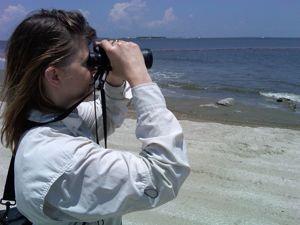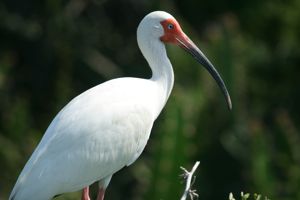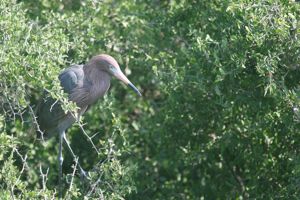Gulf Oil Damage
Air Date: Week of May 21, 2010

Melanie Driscoll, director of the Audubon’s program in Louisiana, scans Grand Island, Louisiana for birds affected by the oil disaster. Behind her is the orange line of an oil boom in the water. (Photo: Jeff Young)
Researchers and conservationists all along the Gulf Coast are collecting data and bracing themselves for the short and longterm effects of the BP oil spill on critical and sensitive wildlife and ecosystems. Living on Earth’s Jeff Young joined researchers in Louisiana and Texas as they monitored bird habitat and to see just what’s at stake in the region.
Transcript
CURWOOD: It’s Living on Earth, I’m Steve Curwood. Recently a reporter with Sky News asked BP CEO Tony Hayward what he thought the oil gushing from his company’s blown out well will do to the Gulf of Mexico.
HAYWARD: I think the environmental impact of this disaster is likely to have been very, very modest. It is impossible to say and we will mount, as part of the aftermath, a very detailed environmental assessment but everything we can see at the moment suggests that the overall environmental impact of this will be very, very modest.
CURWOOD: Well, as much as we might want to think that Mr. Hayward is right many researchers all along the Gulf coast suspect otherwise. They are scrambling to get a handle on the ecological effects of this massive oil spill. And Living on Earth’s Jeff Young has been scrambling along with some of them. His story begins in southern Louisiana.
[SOUNDS OF SURF]
YOUNG: Grand Isle is about as far south as you can get in Louisiana by land—or what’s left of the land, anyway. Erosion and subsidence have melted miles of the surrounding marsh into open water. But this is still crucial bird habitat and an important time for birds—breeding season.
DRISCOLL: There are least terns mating. That would be normal breeding season behavior.
YOUNG: Melanie Driscoll has binoculars pressed to her eyes—as she often does. She directs Audubon’s Louisiana program.
DRISCOLL: They’re just toward the edge of the water, it’s a very quick event—it’s over already.
YOUNG: They’re not big on afterglow, are they?

A White Ibis stands in the Green Island Rookery in Laguna Madre, Texas (Photo: Bart Ballard)
DRISCOLL: [Laughs] Bird copulation is a fairly short-lived event without a lot of ceremony, usually.
YOUNG: The male tern flies back to his mate with a gift—a small fish. In a normal year this would be a happy time and a happy scene for Driscoll, watching resident species take to the nests and thousands of migrants pass through. But this is not a normal year. The long line of bright orange oil booms just offshore reminds us. The dozen or so oil platforms on the horizon remind us. And everything about the terns’ little love scene here now seems loaded with danger—is the oil in the water here? Is it in that fish he just caught?
DRISCOLL: They don’t get any warning. They eat the food, they drink water of the Gulf and they are driven to breed where they’ve bred before, whether that habitat is disturbed or not just affects their success not their drive to breed here.
YOUNG: There are globally important bird areas in these marshes and barrier islands. And some are now taking oil. Driscoll is here to keep tabs on what is likely to be a grim toll. The oil is slowly taking effect just as many birds are most vulnerable. She takes meticulous notes on the sanderlings, turnstones, redknots, brown pelicans. The point is not just to look for oiled or dead birds, but to detect the absence of birds.
DRISCOLL: Because birds will die undiscovered we are less reliant on a body count in this spill because it is so different than eventually a change in abundance, a change in numbers.

A Red Morph in the Green Island Rookery in Laguna Madre, Texas (Photo: Bart Ballard)
YOUNG: So you might not know what’s really going on here until next year?
DRISCOLL: We likely won’t know for a year for some species. Others species many birds, of northern gannets, particularly young, stay out in Gulf for a couple of years until they reach breeding maturity, if those birds are dying it may be three or four years before we notice a change in the nesting population.
YOUNG: It’s so complicated the interaction of things here. As a layperson your impression is well, is there oil on the bird? No? Well, okay! But there’s a lot more to it than that.
DRISCOLL: There’s a saying about ecology that it’s not rocket science, it’s a lot more complicated than that. We’re looking at a system. The birds rely, not just on their feathers insulating them, they rely on food chains that are underwater or in the sand, they rely on protection from predators by being familiar with their surroundings—it’s very complicated.
YOUNG: And it gets more complicated. Several fish stocks in the Gulf were already in serious decline. The mouth of the Mississippi already sees a massive dead zone of low oxygen each year. The land is slipping into the sea. And now comes the oil. Driscoll wonders how much the ecosystem can take.
DRISCOLL We don’t know. We’re playing roulette with these Louisiana marshes. They’re under many, many threats. They’re in a working landscape and that puts them at more risk for oil and gas spills. We don’t know this fragile systems are very productive. There’s a threshold you might have increased productivity before a crash. We’re afraid of the crash. We don’t know what will be the tipping point. The oil makes that tipping point probably closer.

Melanie Driscoll, director of the Audubon’s program in Louisiana, scans Grand Island, Louisiana for birds affected by the oil disaster. Behind her is the orange line of an oil boom in the water. (Photo: Jeff Young)
YOUNG: Driscoll and other scientists and conservationists in the region are settling in for a long haul effort. Stopping the gushing oil in the Gulf may be a race, but understanding the ecological impact is a marathon.
[SOUNDS OF SURF CONTINUE]
YOUNG Somewhere out there just to the southeast is the shifting slick—at times as large as Maryland—and always moving with wind and currents. And underneath? Well, that’s hard to say. Some researchers detected subsurface plumes of oil tens of miles long. But they have questions about just how much oil, its consistency and behavior in the water.
As it turns out, just up the beach on Grand Isle I run into someone who might be able to help answer some of those questions. Hans Thomas is with the Monterey Bay Aquarium Research Institute.
THOMAS: We were brought out by British Petroleum to operate some oceanographic sampling gear. We have a little underwater robot that can swim all the way to the bottom near where the leak site is and sample water and bring it back to us on the ship.
YOUNG: What would you learn from that?
THOMAS: What we’d learn is twofold. First of all, we’d be able to understand how dispersants are interacting with the oil, and then we’d also be able to understand how the oil is distributing itself in the water column, so that we’d have a better idea of exactly how much oil is coming out is and where it is and where it’s going to go.
And one of the things we’re going to try to do with all this data is put it in more of a comprehensive context of how this oil is going to end up impacting both life at the surface of the ocean and, more importantly, life at the bottom of the ocean—at the benthos—and that’s again going to be very critical to understanding what’s going to be going on in this ecosystem five, ten years from now as this oil finally works its way through.
YOUNG: This sounds like great work but we’re standing here on a beach you’re not out there doing your work, why’s that?
THOMAS: Uh, right now, we’re still in consultation with NOAA and BP as to exactly what they want to study with our systems. And I’m hopeful that we’ll get some work done. We came out here to try to help and we’re anxious to do that.
YOUNG: Other scientists are eager for the kind of data Thomas might provide. They are intensely concerned about the sub surface oil. It’s a sort of wild card element here, with major implications for marine mammals like dolphin and the sperm whales that feed not far from the spill site. For the endangered blue fin tuna now spawning in the Gulf. And for sea turtles nesting on Florida’s coasts, that’s where David Godfrey expects to see the oil’s effects soon.
GODFREY: I personally think it’s almost certain that we will.
YOUNG: Godfrey directs the Caribbean conservation corps. He says now that some oil has entered what’s known as the loop current, that will likely bring it to Florida’s waters just as turtle nestlings emerge.
GODFREY: Very shortly, turtles are going to start hatching in the millions from the coast of Florida. And those hatchlings will make their way into the very currents that’s carrying all this oil and tar. And the little turtles are opportunistic feeders. They will grab anything that’s floating around in those currents, namely tarballs so there have been a lot of studies looking hatchlings gathered up in these currents following previous spills and almost every one of them ends up with tar in their mouths and in their guts.
[SOUNDS OF MOTOR BOAT ENGINE]
YOUNG: Across the gulf from those Florida beaches, on the Texas coast south of Corpus Christi, I hitch a ride with a team of scientists from Texas Tech University. The boat skims across the shallow Laguna Madre—the mother lagoon—one of the world’s few hyper-saline coastal ecosystems. Redfish and mullet break the surface, dolphin arc along. Our destination is Green Island. It’s a rookery, jam packed with shorebirds.
[SOUNDS OF BIRDS IN BACKGROUND]
YOUNG: The birds are just everywhere in the brush here. Another roseate spoonbill just went overhead. This is like Manhattan for shorebirds.
YOUNG: Steps lead to a bird blind just above the mesquite and prickly pear. The island is carefully guarded by David Newstead and his crew at the Coastal Bend bays and estuaries program.
NEWSTEAD: There’s a whole range of pretty much all of the herons and egrets that breed on the coast are here—great egrets, great blue herons, we have little blue herons, snowy egrets, tri-colored herons, reddish egrets—there’s both light and dark morph of reddish egrets. This is probably the most important colony for reddish egrets in the world. Up to between 500 to 1000 pairs breeding here.
YOUNG: The whole island is a collage of long legs and feathers, flashes of pink, blue and brilliant white. For Ron Kendall, this is an example of what’s at stake in the Gulf. He directs the Institute of Environmental and Human Health at Texas Tech.
KENDALL: If oil gets access to these kinds of areas it’s not only difficult to clean it up but it could be devastating for the food source. So, you might not have to directly kill the birds by oil but when you take away food source or the habitat—for instance, the turtle grass flats, the inland flats where all your juvenile fish and shrimp and crabs are, those are the areas you got to protect. It’s why all these birds are here.
YOUNG: Now you’ve got the barrier islands out there and we’re a long way from where the oil is now. Are you really concerned that you’ll see oil here?
KENDALL: Well, we know that we’ve had millions and millions of gallons of oil leaked into the Gulf now and some of it is on the surface. But not it’s not necessarily just what’s on surface; it’s what’s in water column or what’s on the bottom. We’ve got a calm day today, but it’s not necessarily always calm and we’re nearing hurricane season. So, we don’t know yet what that can do to mobilize oil that may be existing in plumes below the surface of the sea offshore. It may then translocate that oil from offshore to onshore.
YOUNG: Kendall and his colleagues are already monitoring water and sediment to establish a data baseline and be ready for the first traces of oil. Kendall is a leading figure in wildlife toxicology—he edits a scientific journal and wrote widely used textbooks. And he’s worked on a lot of oil spills. This one has him worried.
KENDALL: The oil is going to go somewhere. We know it’s in the Gulf. And we feel at this time there’s no area in the Gulf Coast that’s truly safe from the effects of this current oil spill.
YOUNG: Looking around, this is such a just ridiculous display of life. It seems so full of life and so strong and resilient an ecosystem; it’s hard to imagine that it couldn’t bounce back against some insult like some oil?
KENDALL: Well, There’s a delicate balance here. All these birds have evolved to utilize these habitats and this resource. To me, here on Green Island and the Laguna Madre, this is an enormous reflection of what these ecosystems can produce just given a little protection, a little chance. And at the same time they can be destroyed and they can be taken away from us very quickly.
[SOUNDS OF BIRD SQUEAKS]
YOUNG: The Gulf Coast is filled with paradoxes. It’s one of our richest fishing grounds and richest oil fields. It floors you with its abundance and variety then reminds you just how fragile the whole thing can be. It has come back from oil spills before. Now those who study the Gulf will monitor, measure and wait to see if it can do it again. For Living on Earth I’m Jeff Young reporting from the Gulf of Mexico.
[BIRD SOUNDS CONTINUE]
[Gipsy Kings “Salsa De Noche” from Compas (Nonesuch Records 1997)]
Links
Living on Earth wants to hear from you!
Living on Earth
62 Calef Highway, Suite 212
Lee, NH 03861
Telephone: 617-287-4121
E-mail: comments@loe.org
Newsletter [Click here]
Donate to Living on Earth!
Living on Earth is an independent media program and relies entirely on contributions from listeners and institutions supporting public service. Please donate now to preserve an independent environmental voice.
NewsletterLiving on Earth offers a weekly delivery of the show's rundown to your mailbox. Sign up for our newsletter today!
 Sailors For The Sea: Be the change you want to sea.
Sailors For The Sea: Be the change you want to sea.
 The Grantham Foundation for the Protection of the Environment: Committed to protecting and improving the health of the global environment.
The Grantham Foundation for the Protection of the Environment: Committed to protecting and improving the health of the global environment.
 Contribute to Living on Earth and receive, as our gift to you, an archival print of one of Mark Seth Lender's extraordinary wildlife photographs. Follow the link to see Mark's current collection of photographs.
Contribute to Living on Earth and receive, as our gift to you, an archival print of one of Mark Seth Lender's extraordinary wildlife photographs. Follow the link to see Mark's current collection of photographs.
 Buy a signed copy of Mark Seth Lender's book Smeagull the Seagull & support Living on Earth
Buy a signed copy of Mark Seth Lender's book Smeagull the Seagull & support Living on Earth

